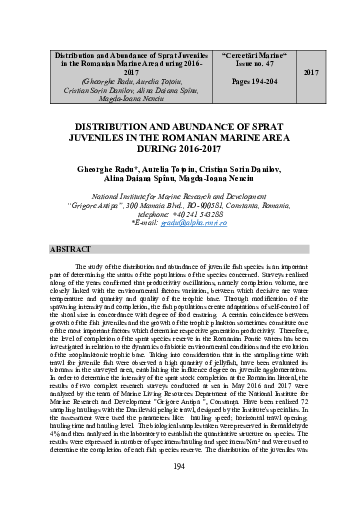Distribution and Abundance of Sprat Juveniles in the Romanian Marine Area during 2016- 2017
DOI:
https://doi.org/10.55268/CM.2017.47.194Keywords:
Romanian Black Sea area, sprat juveniles, distribution, abundance, CompletionAbstract
The study of the distribution and abundance of juvenile fish species is an important part of determining the status of the populations of the species concerned. Surveys realized along of the years confirmed that productivity oscillations, namely completion volume, are closely linked with the environmental factors variation, between which decisive are water temperature and quantity and quality of the trophic base. Through modification of the spawning intensity and completion, the fish populations create adaptations of self-control of the shoal size in concordance with degree of food ensuring. A certain coincidence between growth of the fish juveniles and the growth of the trophic plankton sometimes constitute one of the most important factors which determine respective generation productivity. Therefore, the level of completion of the sprat species reserve in the Romanian Pontic waters has been investigated in relation to the dynamics of abiotic environmental conditions and the evolution of the zooplanktonic trophic base. Taking into consideration that in the sampling time with trawl for juvenile fish were observed a high quantity of jellyfish, have been evaluated its biomass in the surveyed area, establishing the influence degree on juvenile agglomerations. In order to determine the intensity of the sprat stock completion at the Romanian littoral, the results of two complex research surveys conducted at sea in May 2016 and 2017 were analyzed by the team of Marine Living Resources Department of the National Institute for Marine Research and Development "Grigore Antipa ", Constanţa. Have been realized 72 sampling haulings with the Danilevski pelagic trawl, designed by the Institute's specialists. In the assessment were used the parameters like: hauling speed; horizontal trawl opening; hauling time and hauling level. The biological samples taken were preserved in formaldehyde 4% and then analyzed in the laboratory to establish the quantitative structure on species. The results were expressed in number of specimens/hauling and specimens/Nm2 and were used to determine the completion of each fish species reserve. The distribution of the juveniles was done by marking on the distribution maps of the catch values obtained through sampling haulings with the juvenile trawl. Using observations recorded both in 2016 and in 2017, it can be said that the state of the sprat stock is quite unstable, with major fluctuations, from one year to another, of the relative abundance of the sprat juveniles, determined both of environmental modification and fishing pressure on the sprat population, implicitly on spawning stock. So, the causes of this situation are multiple, the effect of each being difficult to be assessed. The estimated abundance for sprat juveniles in May 2017 was lower than in the same period of the previous year. Considering that sprat has a high reproductive capacity and a short life cycle, sprat stocks, although intensely exploited, can be restored more easily than for other species.
Downloads
Published
How to Cite
Issue
Section
License
This is an open access journal, which means that all content is freely available without charge to the user or his/her institution. Users are allowed to read, download, copy, distribute, print, search, or link to the full texts of the articles, or use them for any other lawful purpose, without asking prior permission from the publisher or the author. This is in accordance with the BOAI definition of open access.





